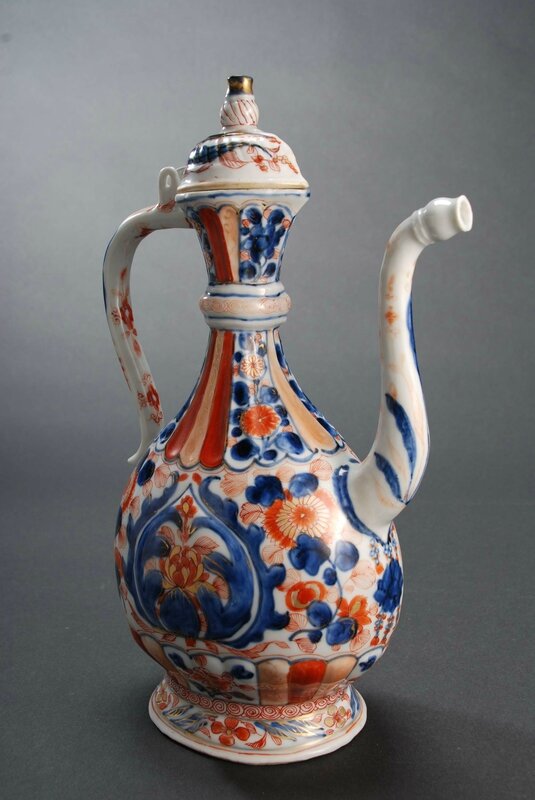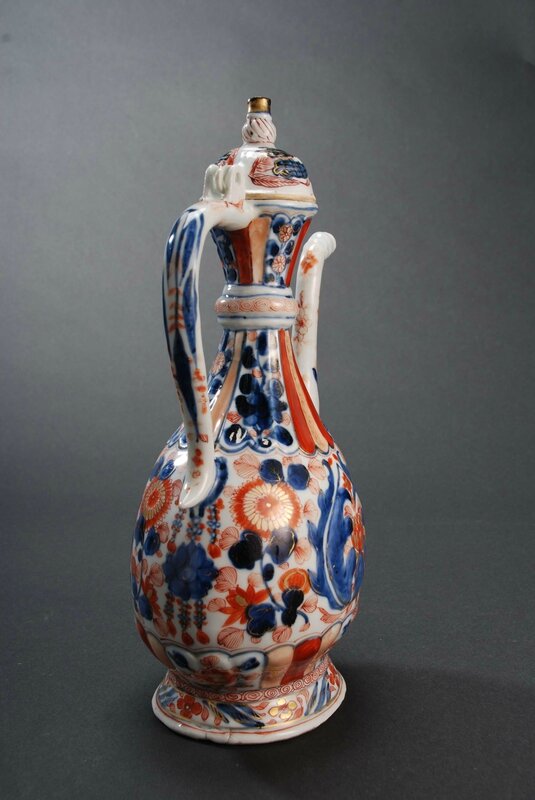Chinese Imari ewer for the Persian market, China, Kangxi Period (1662-1722)
Chinese Imari ewer for the Persian market, China, Kangxi Period (1662-1722). Photo courtesy Vanderven Oriental Art.
Height:30 cm. Price on request
Provenance: Private Collection, The Netherlands
CHINESE IMARI.
In the last quarter of the 17th century the Japanese porcelain factories at Arita (Kyushu) had developed their own styles for decorating the export wares for the Dutch. Blue and white no longer resembled Chinese Kraak and Transitional models, but showed typical Japanese designs such as continuous, boldly painted decorations of large flowers, phoenixes and other mythological animals or mountainous landscapes. In addition, new polychrome wares had become available: Imari and Kakiemon.
Imari, which is called after its distribution centre rear the Arita factories, is characterized by its full, rather bold and asymmetrical decorations painted in underglaze blue, overglaze iron red and lavish gold.
It was an immediate success in The Netherlands where people were used to porcelain decorated in underglaze blue. Enamelled Transitional and early Kangxi pieces had never been widespread and for many of the Dutch this Japanese Imari was the first polychrome porcelain they had ever seen. Although expensive, it was offered in sufficient quantities to conquer the market and create a fashion. Cheaper Delftware imitations soon followed and were able to compete successfully for they were so well painted they were scarcely distinguishable from the Japanese models.
In comparison with the prices of Chinese porcelain in Canton, Japanese porcelain was expensive. Ordering pieces after special models made it even more expensive, but as long as there was a market for it in Europe and a profit could be made, merchants continued to buy it. Noting its success, however, the Chinese, like the Delft potters, started to make imitations which sold at a lower price. Interestingly, close copies of the Japanese models are rare in Chinese Imari, which primarily imitates the combination of colours: underglaze blue, brilliant iron red and thin but shining gold. The designs often resemble those of the Chinese blue and white wares of the period, the red and gold giving them a rich appearance. Among the Japanese motifs that were taken over were kiku (chrysanthemum) roundels and half-roundels, fan shaped panels, partly unrolled bamboo blinds and rather pronounced foliate and floral scrolls. These added to the Japanese flavour, but did not supersede the essentially Chinese decorations, which are generally symmetrical and more refined than the Japanese.
Shapes likewise reflect those of Chinese export porcelain wares in underglaze blue. Garnitures and a variety of objects for dinner services and tea, coffee and chocolate stets constitute the main assortment. European shapes are common, but European designs painted in Chinese Imari are rare, except for armorials and an occasional border pattern in Western style.
Vanderven Oriental Art. Nachtegaalslaantje 1, 5211 LE s-Hertogenbosch, Netherlands

/https%3A%2F%2Fprofilepics.canalblog.com%2Fprofilepics%2F1%2F0%2F100183.jpg)
/https%3A%2F%2Fstorage.canalblog.com%2F03%2F02%2F119589%2F96711876_o.jpg)
/https%3A%2F%2Fstorage.canalblog.com%2F11%2F31%2F119589%2F94773502_o.jpg)
/https%3A%2F%2Fstorage.canalblog.com%2F20%2F83%2F119589%2F94772815_o.jpg)
/https%3A%2F%2Fstorage.canalblog.com%2F26%2F72%2F119589%2F75604929_o.jpg)
/https%3A%2F%2Fstorage.canalblog.com%2F59%2F60%2F119589%2F26458628_o.jpg)




/http%3A%2F%2Fstorage.canalblog.com%2F05%2F64%2F119589%2F128523518_o.jpg)
/http%3A%2F%2Fstorage.canalblog.com%2F78%2F46%2F119589%2F127133605_o.jpg)
/http%3A%2F%2Fstorage.canalblog.com%2F99%2F82%2F119589%2F126892955_o.jpg)
/http%3A%2F%2Fstorage.canalblog.com%2F51%2F84%2F119589%2F122518624_o.jpg)